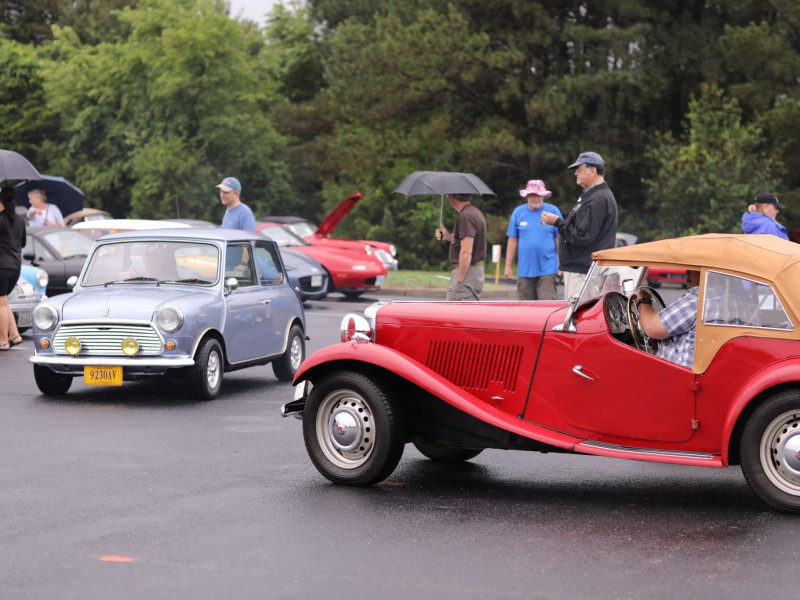By David Clark
The Glory Days of the 1930s were long in the past. It had been 20 years since MG was a dominant force, owning records for absolute speed in the classes between 500 and 2,000cc. The engine in their 750cc overhead cam record breaker, EX127, ultimately made 145bhp, supercharged with 39 lbs of boost—more power a per liter than the uber-dominant Mercedes Silver Arrow Grand Prix cars so generously subsidized by the Nazi regime.
MG founder Cecil Kimber had been sacked at the outset of World War II, allegedly for securing a contract to build the control sections for the Albermarle Bomber, an undertaking that, unbeknownst to Kimber, had been passed on by most of the British aircraft industry who simply couldn’t even begin to fathom how to build it. By the war’s end, the tiny workforce in Abingdon built nearly a thousand units before selling off the test rig they devised to prove its myriad hydraulic and electrical systems.
Peace brought a measure of prosperity back to the “World’s Sports Car Factory” and an entirely new market opened up before them, this time in the United States, where eventually more than two thirds of total production would end up.

It’s easier to spot leaks, particularly of the coolant variety, with the hood off. Twin Cams are the reason MGA 1600s got engine covers with more radius at the front.
Of course MG went racing again, although this time it was mostly in the hands of privateers with some discrete support from Abingdon. Syd Enever built a LeMans body for a TD campaigned by Autosport photographer George Phillips. After being sidelined for a few years so as not to take sales away from their British Motor Corporation stablemate, Austin-Healey, the Enever project became the basis of the MGA, a completely modern MG that featured the new Austin “B” series engine in place of the Morris XPAG engine of the “T” series cars. It wasn’t a particularly elegant design, but at least you could tune it some.
By the late 50s Porsche was beginning to make their presence felt in the same events where MG was contesting less and less successfully. With its intake and exhaust ports siamezed to camouflage its blatant Chevrolet “Stove Bolt” six cylinder engine architecture, the “B” series was never going to breath well enough to go head-to-head with the four-cam Porsche Carrera engines. Something else was needed.
On the quiet, in 1955 Abingdon installed two different Twin Cam engines in the Tourist Trophy MGAs, one of which was completely new, and one designed to be machined on the existing “B” series transfer lines.
By early 1958, BMC management had caved to the persistent demands from Abingdon for the Twin Cam and the new model was announced. It featured a dual overhead cam alloy cylinder head with a 40 degree valve angle in hemispherical combustion chambers, operated by 3/8″ lift cams with a fairly conservative 250 degree split overlap duration—the “B” series prototype.
Domed 9.9:1 compression ratio full-float pistons were initially fitted, later reduced to 8.3:1 in an effort to combat piston failures, which actually were most likely the result of a periodic weak fuel mixture caused by carburetor vibration.
Early engines, like the one pictured here, were notorious oil burners. In a classic example of poor component matchup, the cylinder bores were chrome flashed to improve durability, and equally durable chrome plated piston rings were also fitted, but the chrome rings in chrome bores never seated, with disastrous results for oil control.
More than 50 years on, the cylinders in the Twin Cam engine shown here had no measurable wear at all, and after ball honing them and fitting a Hastings moly ring set, oil consumption is a thing of the past.
Visually striking, and a small marvel of British slide-rule engineering, MGA Twin Cams are rapidly appreciating investments, highly sought after today.

A Chevy dealer from Wakefield, Mass, bought this car at the Arizona RM Auction about ten years ago, knocked it down for $25K. Every time the engine was turning, oil was coming out. When we pulled the engine we found the perp’s fingerprints in the RTC sealer he stuffed all along the bottom of the cam covers in a futile attempt to staunch the flow.
David Clark took a stab at higher learning before he realized it was a waste of his parents’ money, and bought more tools instead. For 30 years he operated a British-only shop with as many as five employees, and became a hunter/gatherer, roaming all six New England States as well as Eastern New York and New Jersey in search of work. Nowadays he’s mostly working on his own cars, but there are exceptions…








'Twin Cam' has no comments
Be the first to comment this post!